INTRODUCTION
Here’s the comic-movie comparison no one wanted. An extremely detailed analysis of Batman and Robin (1997). There isn’t too much serious discussion about this film anywhere on the web, so here's an earnest attempt to objectively evaluate its faithfulness to the source material.
Joel Schumacher has stated he was a fan of the comics long before he made either of his Batman films. In an interview with Jerry Roberts for DGA Magazine, he said:
"I had collected and read Batman comics as a kid [...] One of the things our team brought to the movie was the humor and action of the original comic book. I wanted to emphasize those areas."
In an interview with Batman-On-Film producer Michael Uslan said that Batman and Robin was primarily based on the sixties era Batman comics.
"The 1960s Batman - “Pow, Zap, and Wham.” Fortunately or unfortunately - fortunately for those who only know the 60s TV show - and unfortunately for you and me - BATMAN AND ROBIN was the Batman of the mid-60s."
I think Uslan is basically right on this point. But the movie also references a few stories from the eighties and nineties too, as the following analysis should illustrate. Some of these similarities will be deliberate, others purely coincidental. But all are parallels worth noting.
BATMAN AND ROBIN AND THE COMICS
Let’s start with the casting. George Clooney certainly looks like the Bruce Wayne from the comics.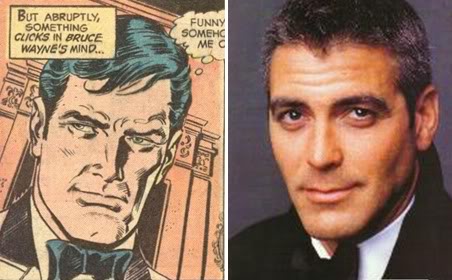
And arguably he looks a lot like the Alex Ross Batman when wearing the suit.
Chris O’Donnell is a perfect physical match for the adult Dick Grayson in the comics. He’s five foot ten with blue eyes, a square jaw and an athletic physique. I suppose you could nitpick that his hair is brown instead of black, but that aside his physical characteristics match the adult Robin’s perfectly.
Robin’s costume in this movie was modelled on the Nightwing costume from the nineties comics. 
There was even a line in the original script that alluded to this.
Mr. Freeze’s appearance in the film is similar to his muscular high-tech look from the nineties comics, which itself was an evolved version of the Otto Preminger version from the TV show.
When we first see Mr. Freeze he’s stealing a diamond from a museum. Before Paul Dini introduced Mr. Freeze’s more sympathetic origin story, his MO typically revolved around ice-themed crimes. He would often try and steal diamonds, seeing as how a slang term for diamonds is ‘ice’. The very first time Batman and Robin encountered Mr. Freeze – back when he was known as Mr. Zero in ‘The Ice Crimes of Mr. Zero’ (Batman #121, February 1959) – he was in the process of stealing diamonds.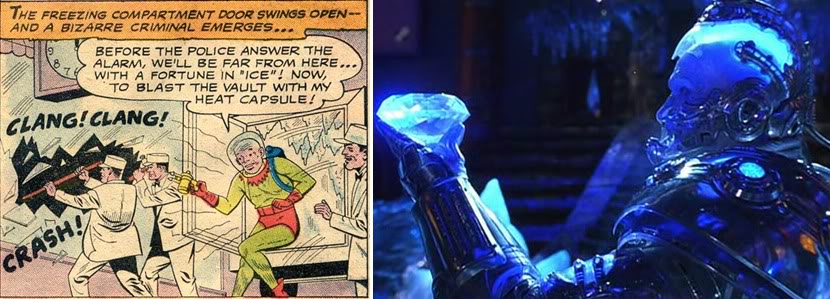
Of course back then he was known as Mr. Zero. He only appeared in one story and was promptly forgotten until writer Max Hodge decided to use him in a two-part story for the Batman television series. Hodge reworked the character to make him more interesting, and he and the rest of the crew imbued him with certain characteristics that were subsequently adopted into the comics. Amongst these were:
• His new name: Mr. Freeze
• His Teutonic background
• His blue skin
Mr. Zero was then reintroduced into the comics in the story ‘Mr. Freeze’s Chilling Deathtrap!’ (Detective Comics #373, March 1968); one of the stories that most heavily influenced Schumacher’s film. This was the first time he appeared as ‘Mr. Freeze’, and his change of name was playfully attributed to the TV show. 
In 1996, Hodge applied for monetary compensation for his part in creating Mr. Freeze. He created a document to support his case containing his notes on the writing of the first script and correspondences with the producer. You can read the whole thing over at www.batfriend.com/data.htm. It’s a fascinating read for anyone who has an interest in the Mr. Freeze character or just the sixties TV show in general.
As far as the casting of Arnold Schwarzenegger goes – well this isn’t a comic influence, but check out this fan letter printed in Batman #479 (June 1992). I love the fact the editor only printed this letter because it was such a terrible idea.
I love the fact the editor only printed this letter because it was such a terrible idea.
Anyway, back to the movie. Mr. Freeze’s freeze-gun functions much the same as it does in the comics.

Batman and Robin show up and are attacked by Freeze’s henchman. During the battle they click their feet together to make skates come out of their boots. Back in the fifties Batman and Robin would often use ‘jet skates’ to quickly manoeuvre around the city. As it happens, they were wearing these the very first time they encountered Mr. Freeze back in Batman #121.
During the skirmish Batman and Robin use ice skates and hockey sticks to fight their opponents. A remarkably similar battle occurred in ‘Murder Masquerade!’ (Batman #268, October 1975) in which Batman and Robin fought their enemies on an ice rink using hockey sticks. They spouted their fair share of hockey-puns too.
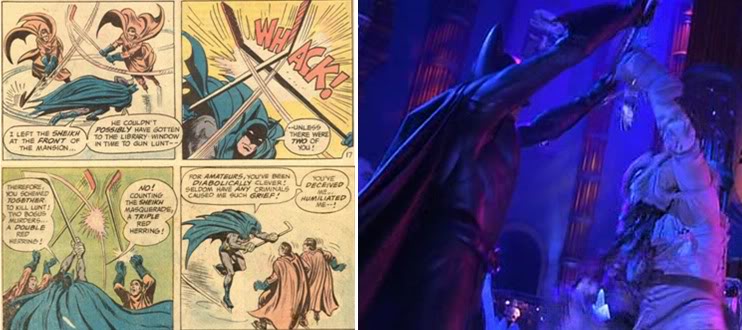
Freeze escapes the museum in his Freezemobile. The Mr. Freeze in the comics drove a vaguely similar vehicle in his second appearance in Detective Comics #373.
Batman then gives chase, firing a grapple hook from a device on his wrist. He, Batgirl and Robin are shown to do this several times throughout the movie rather than using a more traditional hand-held grapple gun as in the previous films. The Batman in the comics has occasionally used a similar wrist-mounted grapple launcher.
Freeze then traps Batman on a rocket heading into space and leaves him to die there. This scenario, whereby the villain leaves Batman in a seemingly inescapable death trap and doesn’t stick around to watch the outcome, was a staple of the old Batman TV show from the sixties. We see a similar example later in the movie where Ivy tries to leave Batman and Robin to die in the Turkish baths.
Robin shows up to rescue Batman and cuts him free using a laser tool. The dynamic duo both carry such tools and made especially prominent use of them in the sixties comics and TV show.
Batman then plants a Batbomb. Again, these have shown up in numerous comics.
The scene of Robin sky-surfing is likely a nod to Pepe Moreno’s 1990 one-shot Digital Justice. Moreno used computer generated artwork to tell a story about a new Batman and Robin protecting Gotham in the future. It had a contemporary cyberpunk feel that I expect would’ve appealed to Joel Schumacher’s visual sensibilities. In this comic Robin has a flying skateboard, and the image of him surfing through the night sky over Gotham is pretty similar to the scene in the movie.
Mr. Freeze using his freeze-gun to facilitate a getaway is typical of the comic character (note the lame ice pun – “Don’t get hot under the collar” – also typical of the early stories).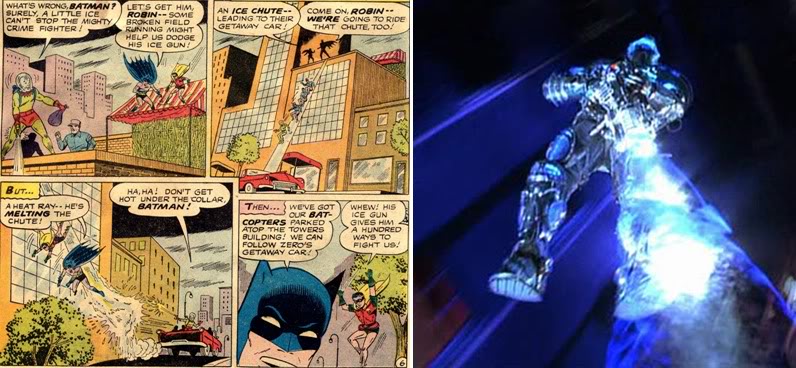
Batman and Robin using their capes like parachutes to slow their descent has also happened many times in the comics.
Mr. Freeze relaxing in a dressing gown while his henchmen freeze in his subzero hideout harkens back to his first appearance in Batman #121.
Moving on to Batgirl. The version in this movie is basically an amalgamation of two characters from the sixties comics: the original Batgirl Betty Kane and Alfred’s niece Daphne.
Betty first showed up on her aunt’s doorstep in ‘Batgirl!’ (Batman #139, April 1961). Her aunt was Kathy Kane, aka Batwoman. But Betty didn’t know this at first. 
In ‘Angel—or Devil?’ (Batman #216, November 1969) we see the first appearance of Alfred’s niece, Daphne. Her arrival is just as abrupt as Betty’s. But Alfred and co welcome her with open arms. Both Betty and Daphne immediately attract the attention of Dick Grayson. 
While we’re on the subject of Alfred’s family its worth mentioning that the Alfred in the comics also has a brother called Wilfred.

Daphne at first appears to be a trustworthy young girl. But she is soon caught snooping around the Manor late at night, up to no good.
The storyline about Alfred’s sickness is yet another element adapted from Detective Comics #373. In the comic it is Aunt Harriet who is sick.
Her condition can only be cured with the aid of a rare cryosurgical instrument which operates on the same principle as Mr. Freeze’s freeze-gun. But this instrument breaks when the doctors try to operate, and Bruce and Dick are told that Aunt Harriet will die unless they can find a replacement device.
Moving on to Poison Ivy now. The version in this movie is pretty accurate to the comics and seemingly takes her cues from Ivy’s first few appearances in the sixties, as well as one particular story arc from the early eighties.

Neil Gaiman’s Black Orchid (1989) revealed that Pamela Isley became the way she is after being experimented on by her college teacher, Jason Woodrue. Woodrue is also responsible for her transformation in the film. In both stories he is revealed to have harboured unrequited feelings towards Pamela.
In the movie Ivy makes her public debut at a charity auction. Batman and Robin were constantly attending these kind of social events in the forties, fifties and sixties. Here’s an example from ‘Batman’s Marriage Trap’ (Batman #214, August 1969). In this scene Batman and Robin attend a beauty contest where the winning girl gets a date with Batman himself. It’s the kind of media-friendly antics the darker Batman would never indulge, but the sixties Batman was only too happy to go along with.
It is during this scene that Batman produces the infamous Bat-credit card. 
Bruce Wayne uses a special credit card to access the batcave beneath the Wayne Enterprises building in 'The "I" of the Beholder' (Detective Comics #511, February 1982). It looks like a regular credit card, but is said to be "specially treated" in some way. Bruce swipes it through an innocuous slot on an elevator control panel, and it takes the elevator down to the batcave. This is the closest thing in the comics I can equate with the Bat-credit card.

When Poison Ivy first appeared in ‘Beware of -- Poison Ivy!’ (Batman #181, June 1966) she made her debut at a weird pop art display showcasing models with peculiar names. Ivy shows up and upstages the other women, introducing herself as the most beautiful of them all. 
Batman is instantly enamoured with her and finds himself distracted to the point that it’s impeding his work. This creates some friction between him and Robin. But in the comic Batman is the one who becomes obsessed with Ivy, while Robin is the one who tries to warn him.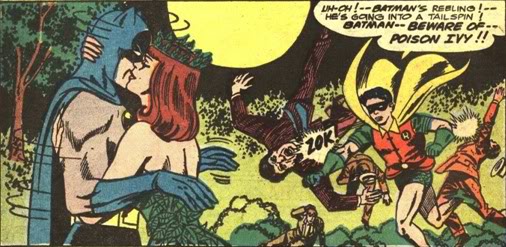
Batman punching a bad guy through a drum is typical of the wacky fight scenes from the Pre-Crisis comics.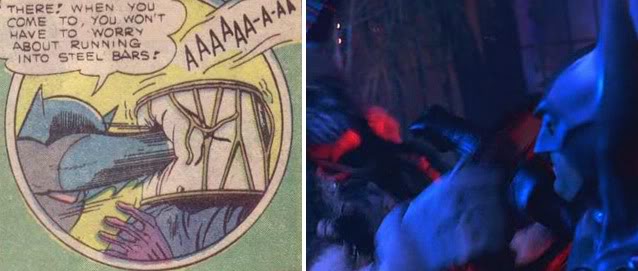
Bruce Wayne is haunted by the memory of Ivy and starts to hallucinate about her when he is with his girlfriend. Batman’s encounters with Ivy often bring about these kind of obsessive hallucinations. A good example would be Ivy’s second appearance in the comics in ‘A Touch of Poison Ivy!’ (Batman #183, August 1966).
Bruce’s girlfriend in the movie is Julie Madison. In the comics, Julie Madison was an actress and Batman’s first girlfriend. She first appeared in ‘Batman Versus the Vampire’ (Detective Comics 31, September 1939) where she was introduced as Bruce Wayne’s fiancée. The movie makes several references to her and Bruce getting engaged, and those are likely nods to their short-lived betrothal in the comics. 
Bane visually resembles his comic counterpart.
Like the Bane in the comics, the movie version is a prison inmate who is subjected to trial tests of a super steroid known as 'Venom'. But the Bane in the comics is a highly intelligent and independent character, whereas his onscreen counterpart is little more than a mindless lackey.
In many ways Schumacher's Bane is closer to another comic character called Evan. Evan was a chauffeur/henchman that served Ivy during a story arc in the early eighties. When he first appeared he was called ‘Evan’. Later he was referred to as ‘Ivor’. It’s possible they’re two separate characters, but since they’re so similar in appearance and personality, and since they both appear within the same story arc, it seems more likely the writer simply changed his name in between issues.

In ‘A Sweet Kiss of Poison’ (Batman #339, September 1981), Ivy disguises herself with a wig in order to manoeuvre in public without being recognised. Note Evan/Ivor driving the car.
Once disguised, she is able to get close to Bruce Wayne and cast her influence over him.
This story arc is finally resolved in ‘Monster, My Sweet!’ (Batman #344, February 1982). In this story Ivy’s moustachioed chauffer – now referred to as ‘Ivor’, but apparently the same guy she’d previously called ‘Evan’ – is transformed into a giant half plant/half human monster.
He is slavishly devoted to Ivy, communicates in short simple sentences and calls her ‘mistress’. She commands him to attack Batman and the two of them do battle.
Ivy mutated Ivor as part of her experiments to try and create a plant/human hybrid.
Meanwhile Barbara Gordon has discovered the Batcave. This scene seems to be another nod to Pepe Moreno’s Digital Justice. When the new Batman and Robin enter the old Batcave in this comic they find a Max Headroom-style computerised version of the original Batman talking to them through the Batcomputer. The computerised Batman explains that he anticipated someone might take up the mantle and has prepared costumes and equipment for his successors. 
Elsewhere, Batman and Robin fall into Ivy’s trap. The idea of a villain carrying off the Bat-Signal and using it to lure Batman into a trap was also featured in Batman versus Predator (1991).

Robin briefly got his own signal in the comics in 'The Vanished Batman' (Batman #101, August 1956).

Over the years Ivy has developed a seemingly supernatural ability to control vines. Here’s an early example of her setting vines on Batman to crush/strangle him to death. This is taken from the aforementioned Batman #339.
The confrontation between Ivy and Batgirl in the movie showcases the former’s skills at unarmed combat. These too are evidenced in Batman #344.
In this issue she is also shown using a vine like a whip, snaring an opponent’s ankle the way she does in the movie.
Going back to Batman #139, the first time Batgirl appeared in costume was when she came to the aid of Batman, Robin and Batwoman, all of whom had been incapacitated by a villain. Batgirl sprang through a window and helped them.

At first they didn’t realise who she was under the mask. But then she explained that she’d discovered her aunt’s secret identity and taken the initiative of creating one for herself. Also note that the Betty Kane Batgirl didn’t wear a full cowl like Barbara Gordon did, instead sporting a simpler eye mask that left her blonde hair exposed.
Later in the film Batgirl wears a cowl reminiscent of the Barbara Gorgon Batgirl’s costume. She is also shown riding her Batgirl-cycle, the signature vehicle of the Gordon Batgirl since her debut in 1967.
The plot about Mr. Freeze trying to freeze Gotham with a giant freeze-cannon is taken from ‘The Glacier Under Gotham!’ (Batman #375, September 1984). 

A lot of people question Batman’s sudden change of costume towards the end of the film. The comic adaptation explains that the new Arctic suit is resistant to extreme cold, including Mr. Freeze’s freeze-gun.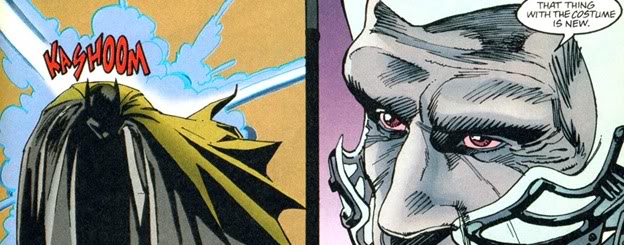
Batman in the comics has a variety of different costumes for different environments, including special thermal suits for cold climates.
The idea of Freeze being incapacitated after having his suit damaged is one used many times in the comics. 
‘Hot House’ (Legends of the Dark Knight #42-43, 1993) ends with Ivy playing he loves me/he loves me not in her cell.
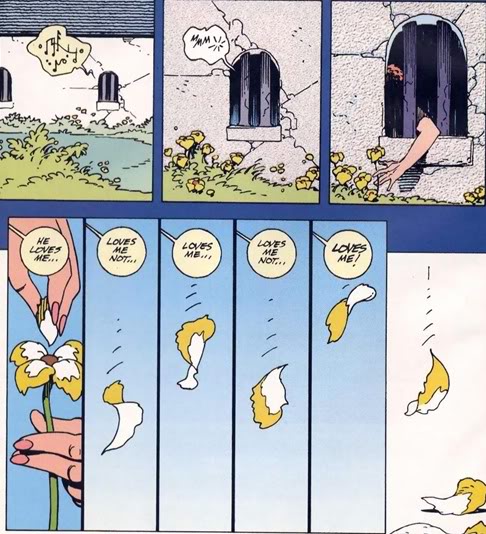
And as for Alfred’s/Aunt Harriet’s illness – in Detective Comics #373 Batman and Robin are able to defeat Mr. Freeze and take his freeze-gun to the surgeons at the hospital. They then use it in a cryosurgical procedure to save Aunt Harriet and the story ends with her making a full recovery.
And on that happy note I’ll end this overlong analysis.














by Kamdan
by Silver Nemesis
by Silver Nemesis
by Gotham Knight
by The Joker
by The Joker
by Silver Nemesis
by The Joker
by The Laughing Fish
by The Laughing Fish